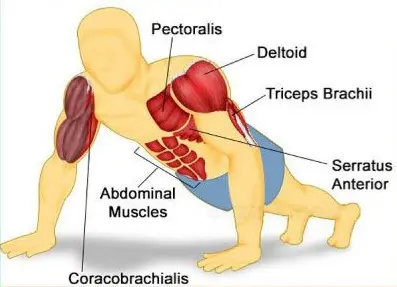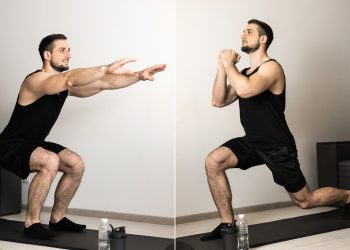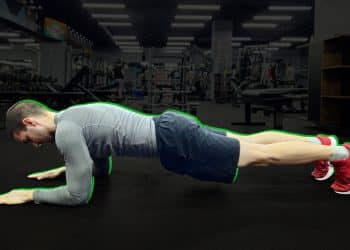Push-ups are arguably the most widely performed exercise in the world. Everyone from professional athletes down to kids in PT class does push-ups. In fact, almost everyone who has ever worked out has done push-ups at some time or another.
While regular push-ups are the perfect upper body exercise, if that’s all you ever do, you may eventually start to get bored of them. You could also find that they no longer provide enough overload to develop your fitness further.
The good news is there are LOTS of different types of push-up to try!
In this article, we take an in-depth look at deficit push-ups, revealing why and how to do them and the best variations and alternatives.
Deficit Push-Ups – Muscles Worked
Deficit push-ups are a compound exercise. That means they involve several joints and muscles working together. While deficit push-ups are most definitely an upper body exercise, they also affect your midsection and even your legs. The main muscles trained during deficit push-ups are:
Level Up Your Fitness: Join our 💪 strong community in Fitness Volt Newsletter. Get daily inspiration, expert-backed workouts, nutrition tips, the latest in strength sports, and the support you need to reach your goals. Subscribe for free!
Pectoralis major – known as your pecs for short, these are your largest chest muscles. Their primary functions are horizontal flexion and adduction of your shoulders. Deficit push-ups are an excellent exercise for pumping up your pecs in place of bench presses, making them ideal for home exercisers.
Triceps brachii – located on the back of your upper arms, the triceps brachii or triceps for short extend your elbows. For many people, the triceps are the weak link and muscle that fails first during deficit push-ups.
Pectoralis minor – pec minor is a thin, flat muscle that lies underneath the pec major. It assists your pec major during push-ups and also prevents your shoulders from lifting.
Serratus anterior – looking not unlike the serrated edge of a knife, the serratus anterior is located on and between your upper ribs. Its primary function is keeping your scapulae flat against your ribs, increasing shoulder girdle stability.
Anterior deltoids – while all three deltoid heads (anterior/medial/posterior) are involved in push-ups, the anterior deltoid is most active. Working with the pecs, the anterior deltoid flexes the shoulder joint. The medial and posterior deltoids mostly work as stabilizers during deficit push-ups.
Core – core is the collective term for the muscles that make up your midsection. These muscles include rectus abdominis, obliques, transverse abdominis, and erector spinae. The core contracts isometrically or statically to keep your body straight during deficit push-ups.
Quadriceps – located on the front of your thighs, the quads work isometrically to keep your legs straight during deficit push-ups. The four quadriceps muscles are rectus femoris, vastus lateralis, vastus medialis, and vastus intermedius. However, the load on these muscles is relatively low, so doing deficit push-ups probably won’t do much for your leg development or strength.
How to Do Deficit Push-Ups

Get more from deficit push-ups while keeping your risk of injury to a minimum by following these guidelines:
- Create a deficit by placing two dumbbells on the floor, a couple of bumper plates, yoga blocks, or by using push-up handles or parallettes. Whatever you use should be slightly wider than shoulder-width apart.
- Squat down and place your hands on the raised implements.
- Walk your feet out and back so that your legs, hips, and shoulders form a straight line. Brace your core and pull your shoulders down and back. Tense your legs and glutes, too. Tuck your chin in and lengthen your neck.
- Bend your arms and lower your chest down between your hands. Your range of motion will depend on your shoulder flexibility and joint health. However, take care not to hyperextend your shoulders by descending too deeply.
- Keep your upper arms close to your sides and your wrists straight.
- Push yourself back up and then, at the top of the rep, shrug your shoulders forward to activate the serratus anterior fully.
- Reset your shoulders and then descend into another rep.
Deficit Push-Up Benefits and Drawbacks
Not sure if you want to add deficit push-ups to your workouts? Consider these benefits:
Increased range of motion – when you do regular push-ups, each rep stops when your chest touches the floor. But, with the deficit variation, you can descend beyond this point, taking your chest, shoulders, and triceps through a larger range of motion. More distance traveled per rep means deficit push-ups are more challenging than regular push-ups.
Less wrist strain – using dumbbells or push-up handles means you can keep your wrists in a neutral position instead of bending them back to put your palms flat on the floor. If regular push-ups bother your wrists, deficit push-ups could provide welcome relief.
Less painful shoulders – if you use dumbbells or push-up handles, you’ll be able to keep your shoulders and arms in a neutral position instead of medial rotation. If push-ups cause shoulder pain, switching to the deficit variation could alleviate the problem.
Better for hypertrophy – the increased range of motion at the shoulders and elbows means that deficit push-ups may be better for building muscle than regular push-ups. They’re also more challenging, so you should find that it won’t take as many reps to fatigue the target muscles.
While deficit push-ups are a mostly beneficial exercise, there are also drawbacks to consider:
More shoulder wear and tear – while adopting a neutral grip can take the stress off your shoulders, the increased range of motion could also lead to shoulder pain, especially if you descend too far. As such, it’s best to use a modest deficit, e.g., 6-9 inches, and don’t try and force your chest to the floor. Instead, increase your range of motion gradually and reduce the deficit if your shoulders start to hurt.
9 Deficit Push-Up Variations and Alternatives
Deficit push-ups are a highly effective bodyweight upper body exercise, but that doesn’t mean you need to do them all the time. There are several variations and alternatives you can use to keep your workouts productive and interesting:
Level Up Your Fitness: Join our 💪 strong community in Fitness Volt Newsletter. Get daily inspiration, expert-backed workouts, nutrition tips, the latest in strength sports, and the support you need to reach your goals. Subscribe for free!
1. Decline deficit push-ups
Decline deficit push-ups involve raising your feet to put more weight on your arms. This makes them harder and increases upper pec activation. The higher you raise your feet, the more demanding this exercise becomes. A knee-high bench or low chair is a good place to start for most exercisers.
Learn how to do decline push-ups here.
2. Resistance band deficit push-ups
You can do deficit push-ups wearing a weighted vest or backpack. However, another way to increase the difficulty of deficit push-ups is with a resistance band. Adding a band increases tension as you extend your arms and approach lockout. This is good for building stronger triceps and is also shoulder-friendly, as the load at the bottom of each rep is significantly lower than at the top.
How to do it:
- Place your band around your upper back and hold the ends. Adopt the deficit push-up position with the band beneath your hands.
- Walk your feet out and back so that your legs, hips, and shoulders form a straight line. Brace your core and pull your shoulders down and back. Tense your legs and glutes, too.
- Bend your arms and lower your chest down between your hands. Your range of motion will depend on your shoulder flexibility and joint health.
- Push yourself back up and then, at the top of the rep, shrug your shoulders forward to activate the serratus anterior fully.
- Reset your shoulders and then descend into another rep.
3. Knuckle push-up
Knuckle push-ups are a traditional part of martial arts training. They’re done to increase wrist strength and toughen up the fists. They also create a slight deficit without having to use things like dumbbells or yoga blocks. On the downside, knuckle push-ups require good joint stability, and failing to maintain neutral wrists could cause injury.
How to do it:
- Make a fist with both hands. Do not tuck your thumb inside your clenched fist. Instead, place it around your first two fingers.
- Squat down and place your fists on the floor, roughly shoulder-width apart. Your palms should be turned inward in a neutral position. Make sure your wrists are straight.
- Keeping your arms straight, walk your feet back, so your legs and body are aligned. Brace your core and lengthen your neck. Tuck your chin in.
- Without dropping your head or hips, bend your arms and lower your chest to within an inch or so of the floor.
- Push yourself back up and then repeat.
- Make knuckle push-ups more comfortable by resting your hands on an exercise mat or folded towel.
4. Push-Ups with Single-Arm Deficit
This variation emphasizes one arm at a time. It’s not quite a single-arm push-up, but it’s definitely a step in that direction. The deficit increases your range of motion, and you’ll need to push off explosively off the floor to complete each rep, making this a good power exercise.
How to do it:
- Place 1-3 weight plates or a yoga block on the floor. It’s not recommended to do this exercise with a dumbbell or push-up handle.
- Adopt the push-up position with one hand on the plate(s) and the other on the floor. Your hands should be about shoulder-width apart. Brace your core and pull your shoulders down and back.
- Bend your arms and lower your chest down toward the floor.
- Pushing mainly on the elevated hand, press yourself back up and touch your opposite shoulder with your non-raised hand.
- Place your hand back on the floor and repeat.
- Do the same number of reps on each side.
5. Suspension trainer push-ups
Suspension trainer (e.g., a TRX or gymnastic rings) push-ups combine a deficit with instability to really challenge your pecs, triceps, and core. Make this exercise easier by shortening the straps and raising the handles or more challenging by setting the handles closer to the floor or lifting your feet.
How to do it:
- Set your suspension trainer handles to the required height.
- Take a handle in each hand, so your palms face inward, i.e., a neutral grip.
- With your arms straight, walk your feet back and into the push-up position. Brace your core and stabilize your arms.
- Bend your arms and lower your chest down between your hands. Your range of motion will depend on your shoulder flexibility and joint health.
- Keep your upper arms close to your sides and your wrists straight.
- Push yourself back up and then, at the top of the rep, shrug your shoulders forward to activate the serratus anterior fully.
- Reset your shoulders and then descend into another rep.
6. Renegade rows/deficit push-ups
This deficit push-up variation doesn’t just work your chest, shoulders, and triceps. Instead, it works your upper back and biceps, too. It’s also a very core-centric exercise. This is the ideal exercise if you are short of time but still want to train your entire upper body and midsection.
How to do it:
- With a dumbbell in each hand, squat down and adopt the push-up position. Your hands should be roughly shoulder-width apart, palms facing inward. Brace your core and pull your shoulders down and back. Make sure your wrists are straight.
- Bend your arms and lower your chest down between your hands.
- Push yourself back up.
- Next, bend one arm and row your dumbbell up and into your lower ribs. Keep your shoulders and hips stationary, and do not bend your legs.
- Lower the weight to the floor and do another push-up.
- Do your next row with the other arm.
- Continue this push-up/row/push-up/row sequence for the desired number of reps.
7. Neutral grip dumbbell bench press
Neutral grip dumbbell bench presses use a similar movement to deficit push-ups. Using dumbbells rather than a barbell for bench presses means that you can lower the weights further. And, unlike push-ups, you can easily change the weight to match your training goal. This is a very shoulder-friendly pressing exercise that can be done using a flat, incline, or decline bench and also on the floor (dumbbell floor presses).
Learn how to do neutral grip dumbbell bench presses here.
8. Parallel bar dips
Like deficit push-ups, parallel bar dips are a classic bodyweight chest exercise. However, because your feet aren’t resting on the floor, there is significantly more weight on your arms, making them a whole lot harder. Dips are a viable alternative to the bench press and emphasize the lower region of the pecs.
Read more about parallel bar dips here.
9. Medicine ball push-ups
Like suspension trainer push-ups, medicine ball push-ups combine an increased range of motion with instability to challenge your pecs, delts, triceps, and core. Ideally, you should use equal-sized medicine balls but, if that’s not possible, simply swap the balls over rep by rep.
How to do it:
- Place two firm medicine balls on the floor. They should be slightly wider than shoulder-width apart.
- Squat down and place your hands on the top of each ball.
- Walk your feet out and back so that your legs, hips, and shoulders form a straight line. Brace your core and pull your shoulders down and back.
- Bend your arms and lower your chest down between your hands.
- Push yourself back up and then, at the top of the rep, shrug your shoulders forward to activate the serratus anterior fully.
- Reset your shoulders and then descend into another rep.
Deficit Push-Ups – Wrapping Up
The humble push-up is an equal opportunities exercise; it doesn’t matter what who you are, or you are training for, doing plenty of push-ups is bound to help your cause! Deficit push-ups are a little more taxing than the standard variety because they involve a larger range of motion.
That increased ROM is a double-edged sword because lowering your chest down between your hands also puts more stress on your shoulder joints. That said, if your shoulders are mobile and healthy, this shouldn’t be an issue.
If regular push-ups no longer provide enough overload for your pecs, delts, and triceps, upgrade your workouts with deficit push-ups. This one small change will have a significant impact on your muscular development and performance.
Interested in measuring your progress? Check out our strength standards for Bench Press, Dumbbell Floor Press, Push Ups, and more.












